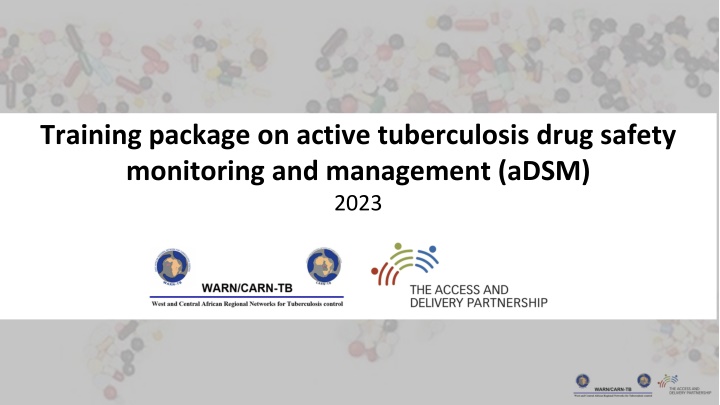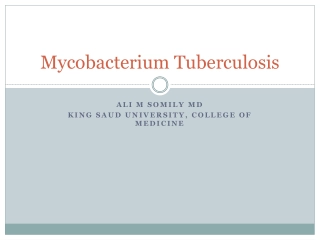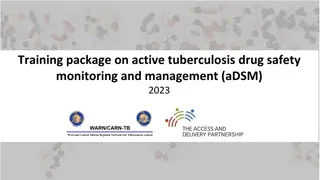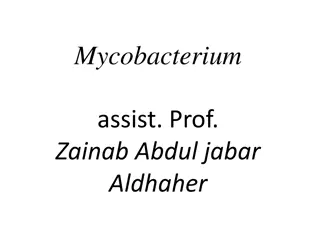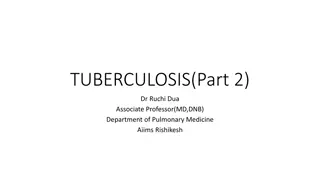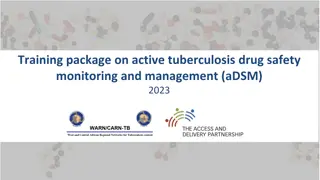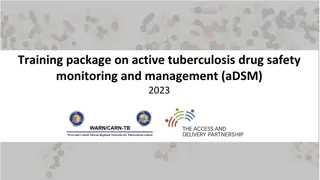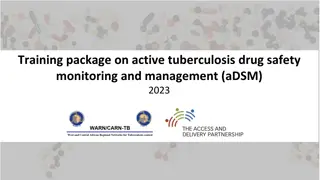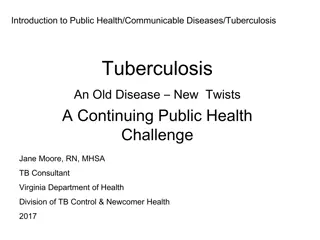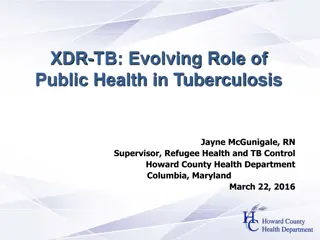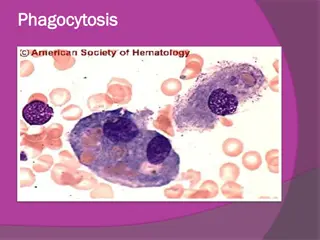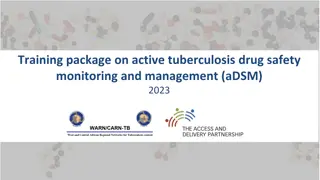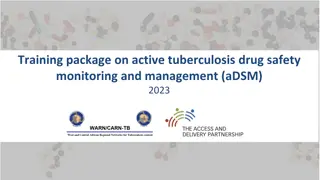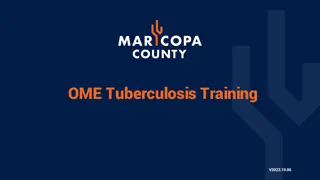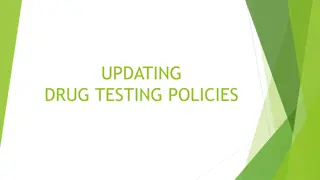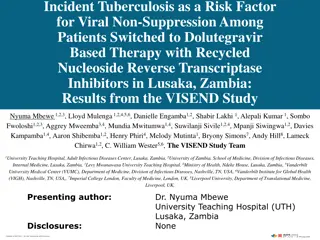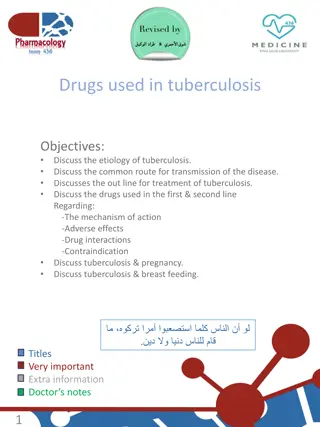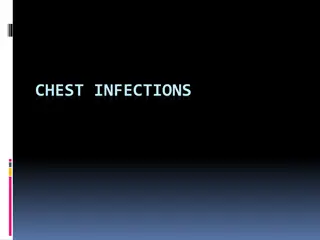Training package on active tuberculosis drug safety
This training package focuses on defining common terms in active TB drug safety monitoring, differentiating adverse events and treatment outcomes, and outlining the role of pharmacovigilance in detecting, understanding, and preventing drug-related issues. It provides insights into active TB drug safety monitoring and management as outlined by WHO guidelines, including identifying, managing, and reporting toxicities in patients on new TB drug regimens. Additionally, it covers key definitions related to adverse events, drug reactions, serious adverse events, and severe adverse events.
Download Presentation

Please find below an Image/Link to download the presentation.
The content on the website is provided AS IS for your information and personal use only. It may not be sold, licensed, or shared on other websites without obtaining consent from the author.If you encounter any issues during the download, it is possible that the publisher has removed the file from their server.
You are allowed to download the files provided on this website for personal or commercial use, subject to the condition that they are used lawfully. All files are the property of their respective owners.
The content on the website is provided AS IS for your information and personal use only. It may not be sold, licensed, or shared on other websites without obtaining consent from the author.
E N D
Presentation Transcript
Training package on active tuberculosis drug safety monitoring and management (aDSM) 2023
Learning objectives By the end of this presentation, the participant is expected to be able to 1. Define the most common terms used in active TB drug safety monitoring and management (aDSM) Differentiate between what is an adverse event and what is a treatment outcome 2.
Pharmacovigilance (PV) WHO Science and activities related to the detection, assessment, understanding, monitoring and prevention of drug safety, while taking early action to avert treatment interruption and other unfavourable patient outcomes
Active TB drug safety monitoring and management (aDSM) WHO active and systematic clinical and laboratory assessment of patients on treatment with new TB drugs, novel MDR-TB regimens or XDR-TB regimens to detect, manage and report suspected or confirmed drug toxicities apps.who.int/iris/bitstream/10665/204465/1/WHO_HTM_TB_2015.28_eng.pdf
Further definitions 1 Adverse events (AE): Any untoward medical occurrence that may present during treatment with a pharmaceutical product, but which does not necessarily have a causal relationship with this treatment Adverse drug reactions (ADR): a response* to a medicine which is noxious and unintended, and which occurs at doses normally used in humans not in case of errors** * Response = a causal relationship between a medicine and an adverse event is at least a reasonable possibility ** an error which occurs during the prescribing, dispensing and/or use of a medication is called a medication error
Further definitions 2 Serious adverse event (SAE): an AE which either leads to death or a life-threatening experience; to hospitalization or prolongation of hospitalization; to persistent or significant disability; or to a congenital anomaly. Any SAE that do not immediately result in one of these outcomes but that require an intervention such as termination of the drug suspected of having caused the event. Severe adverse event: an AE of maximal intensity as judged by the patient and/or the clinician; at times this assessment is based on laboratory or clinical tests. Different scales exist to determine the degree of severity, the simplest being mild , moderate , or severe
Further definitions 3 Adverse event of clinical significance: Is an AE that is either: (i) serious, (ii) of special interest, (iii) leads to a discontinuation or change in the treatment, or (iv) is judged as otherwise clinically significant by the clinician Adverse event of special interest: Is any AE documented to have occurred during clinical trials and for which the monitoring programme is specifically sensitized to report regardless of its seriousness, severity or causal relationship to the TB treatment
e.g: Adverse event of special interest All Serious AEs Peripheral neuropathy (paraesthesia), Psychiatric disorders and central nervous system toxicity (psychosis, depression, seizures, ) Optic nerve disorder (optic neuritis) or retinopathy Ototoxicity (hearing impairment, hearing loss) Myelosuppression (anaemia, thrombocytopenia, neutropenia, ) Prolonged QT interval (Fridericia correction) Lactic acidosis Hepatitis (increase AST/ALT >= 5x ULN or >=3 x with clinical manifestations, increase bilirubin>=1.5 ULN) Hypothyroidism, Hypokalaemia, Pancreatitis Phospholipidosis Acute kidney injury (acute renal failure)
Further definitions 4 Signal: reported information on a possible causal relationship between an adverse event and a TB medicine, the relationship being unknown or incompletely documented previously or representing a new aspect of a known association Drug-safety profile: Is a description of the benefits, risks and toxicity of a given TB drug or regimen, specifying any known or likely safety concerns, contraindications, cautions, preventive measures and other features that the user should be aware of to protect the health of a TB patient
Further definitions 5 Causal relationship: The relationship between an exposure (A) and an event (B) in which A precedes and causes B. This may refer to the causal association between an exposure to a TB medicine and the occurrence of an adverse reaction Causality assessment: the evaluation of the likelihood that a TB medicine was the causative agent of an observed adverse reaction Rechallenge: the voluntary or inadvertent re-administration of a medicine suspected of causing an adverse reaction Dechallenge: the withdrawal of a drug from a patient; the point at which the continuation, reduction or disappearance of adverse reaction may be observed
SAE, deaths and outcomes In aDSM, death is an outcome and not automatically defined as a SAE* Deaths and other unfavourable outcomes - treatment interruption or loss to follow-up, permanent disability, medication change or treatment failure - should trigger the search for a preceding AE If an AE is confirmed or suspected to have preceded the outcome then causality assessment needs to follow to check for any plausible association and its certainty If it is confirmed that an AE was causally related to a death or disability or a life-threatening outcome then the event can be classified as serious * This is in distinction from a treatment trial in which death is usually defined as a SAE. Intervention trials are mounted for different purposes and have a different dynamic from aDSM
Outcomes Outcomes for TB cohorts are well standardised* It may be useful to record additional details when treatment is stopped prematurely : Adverse event Patient decision Clinician decision (e.g. pregnancy, medication change) Treatment no longer needed Medicine(s) out of stock Other *Definitions and reporting framework for tuberculosis 2013 revision (updated December 2014 and January 2020) https://apps.who.int/iris/bitstream/handle/10665/79199/9789241505345_eng.pdf?sequence=1&isAllowed=y
Acknowledgements The development of the aDSM training material was funded by TDR as part of the Access and Delivery Partnership (ADP) with funding from the Government of Japan. These training materials were put together in 2016 the WHO Task Force on aDSM with technical partners KNCV Tuberculosis Foundation, Management Sciences for Health (SIAPS), MSF, WHO GTB, and TDR. The materials were updated in 2022-23 by Mahamadou Bassirou Souleymane (TDR consultant) with Marie-Eve Raguenaud (TDR), Branwen J Hennig (TDR), and Corinne Merle (TDR), and reviewed by Linh Nhat Nguyen (WHO/GTB), Medea Gegia (WHO/GTB), and Fuad Mirzayev (WHO/GTB). We thank all members of the WARN/CARN-TB working group on aDSM who contributed to the development of the aDSM generic guidelines as well as the secretariat, particularly Dr Christ Houessinon: Disadidi Ambrioso, Esse Marius, Adomou Jamal Rouamba Ruffine, Haro Sougrimani, Koumbem Boureima, Nsanzerugeze Jos lyne, Tollo Tollo Daniel Alphonse D sir , Mpaba Minkat Th ophile Mistral, Julie Abessolo, Ursule IDOKO, Tijan Baldeh , Wandifa Samateh, Tida S Kinteh, Alieu Wurie, Mardemn Yeasuen, Benjamin K. Quenneh, Cheick Oumar Bah, Kane El Hadj Malick, Aw Idriss, Mamoudou Hama Rachida, Gagara I. M. Assiatou, Katamb Balkissa, Seiyabatou ElhSaidou, Liombo Anastasie, Lunganyu Junior, Kitambala Sentime, Lula Yves , Habimana-Mucyo Yves, Migambi Patrick, dos Santos Brigite, Castro V nia, Wadson Cruz, Gueye Aminata, Mukeh Fahnbulleh, Bailor Samuel, Manjo Lamin, Saleh Mahareb Abdoulaye, Haroun Saleh Naima, Mouhoudine Yerima, Kpelafia Silifa
